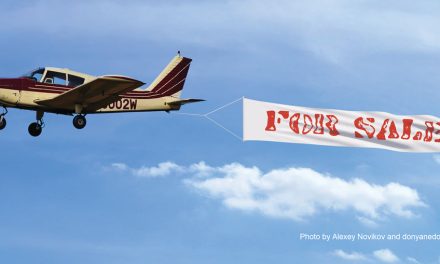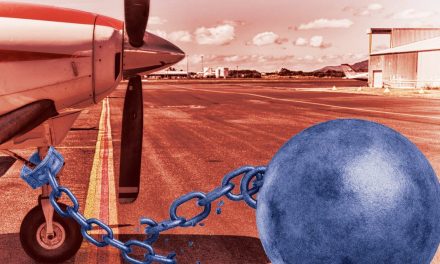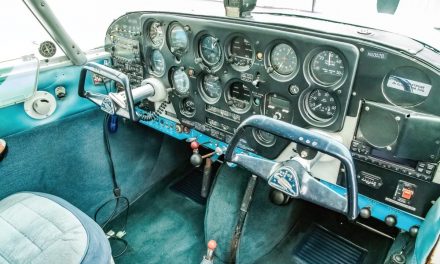Aviation insurance continues to get higher priced and harder to get. In fact, it’s now one of the top three costs of owning an aircraft; that is, if you need to even buy insurance. Remember, only 12 states require insurance. If your state and airport don’t require it and you didn’t borrow money from a bank, you don’t have to purchase insurance. But before you make that decision, talk to your legal and financial advisers. Sometimes insurance is just a necessary evil, as some call it.
I think it’s important to note that insurance premiums aren’t the only thing that have been increasing the cost of flying. The requirements that are being put on pilots, such as new ratings, factory schools, and minimum hours, are also increasing the cost of ownership. Add to that the cost of replacement parts, price spikes because of supply chain shortages, and increased aircraft values overall, and it’s expensive to fly.
Recently, I was talking to a customer. We were discussing not only the premium increase for aircraft, but also for real estate, automobiles, and more. Insurance premiums are increasing in all areas of the economy, and some states are worse than others, that is, if you can even get insurance in some of those states, but that’s another issue.
Let’s review basic aviation coverages. I’m a believer in carrying the minimum of at least the liability portion, which is the cheapest part of an aviation policy. This portion covers the property damage and bodily injury to third parties that you’re found liable for. The more you can buy, the better. Even though most insurance companies will restrict how much liability insurance you can buy, it’s one area that you shouldn’t be without. Not only can the million dollars come in handy, but so can the legal costs that the insurance company takes on in your defense.
What Is Hull Coverage?
Hull coverage is the protection for the physical value of the aircraft. It’s also the portion of insurance that will cover any loss from theft or other damage. If your hangar collapses and crushes your aircraft, hull coverage will cover it. If your radios are stolen, hull coverage should cover them.
The advantage of hull coverage is that it is an established value. If the aircraft is destroyed, you lose whatever it was worth, nothing more. In some cases, the owner can absorb hull value, but not the liability risk. If you need hull coverage, there are variations or different levels of coverage.
How Much Hull Coverage?
Aviation insurance is usually an “agreed value” policy. That means if you have a total loss, the claims department will pay the “agreed value” of the policy (minus your deductible). As the owner of the insured aircraft, it’s your decision to establish a reasonable value. Most underwriters will allow you to price your aircraft higher or lower than the average book value as long as you can provide proof of the value (POV). POV is usually an equipment list that includes avionics, any modification made to the aircraft, the engine and airframe hours, and condition of the interior and exterior. Lately, underwriters have been allowing about a 10% deviation without any proof. Anything over 10% requires POV, and even then, that doesn’t mean you’ll get the value you want.
One thing to remember when establishing the hull value, book values are just a guideline. Your aircraft might be worth a lot more or less than the book says. Always keep a list of everything in the aircraft and a few pictures of the panel, as well as the inside and outside, and anything else that can help prove the aircraft’s value in case you need to file a claim.
Types of Hull Coverage
There are three types of hull coverage, with each insurance company having its own variations. These basic coverages are ground not-in-motion (GNIM); ground not-in-flight (also known as ground and taxi or G&T); and ground and flight (G&F). Ground not-in-motion coverage applies when the aircraft is parked and/or not under its own power. Ground not-in-flight applies when the engine or engines are actually moving the aircraft. Ground and flight is essentially full coverage: on the ground, during taxi, and in the air.
Many companies don’t include any coverage during taxi under the GNIM part of the policy. That means if all you have is GNIM, you have no coverage during taxi for the hull value. And beware, G&T doesn’t usually cover an aircraft on the takeoff roll or landing roll. And if you have G&F and have an accident during taxi time, you’ll be responsible for the G&F deductibles. Depending on the aircraft, the G&F deductibles can be quite high, say 10% of the hull value.
The Three Basic Hull Coverages:
- Ground not-in-motion (GNIM)
- Ground not-in-flight (also known as Ground and Taxi or G&T)
- Ground and flight (G&F)
The typical hull claim is for theft, damage from an accident, or from a weather problem, such as hail, snow, or a tornado, and gear-up landings. Most insurance companies will provide coverage for these problems if you were qualified in the aircraft, met the policy requirements, and the aircraft was in current FAA-approved flight. Any deviation from the FARs or the policy, however, could possibly make your claim excluded or at least a tremendous legal battle.
Like any other business, insurance companies are in the business to make money (although most will be lucky to make any underwriting profit on small general aviation aircraft), so they try to protect themselves as much as possible. The usual way they do that is by controlling their losses. These controls are in the form of higher premiums and deductibles and stiffer, more stringent underwriting requirements, such as for training, school, and dual. All these decisions are based on the insured aircraft, pilot experience, repair costs, and loss history for the aircraft type.
Saving Money by Changing Coverage
So, what can you do to cut your insurance costs? Well, besides flying a simple, single-seat, fixed-gear aircraft based at an ATC- controlled 10,000-foot runway, at an airport with no other traffic but you, you could lower the hull coverage. An example might be to buy your aircraft and put full coverage on the aircraft for the first year. After you get comfortable in the aircraft, maybe 100 or so hours, reduce the hull coverage to ground not-in-motion or ground and taxi. In my area, the big fear is the storms that come through the state. I’m pretty comfortable flying the aircraft and willing to lose a few bucks if I screw up the landing. But I hate to have a tornado come through town and drop the hangar on the aircraft and total it.
Questions to Consider
A few questions to think about before you change hull coverage:
- Do I have bank financing on my aircraft? (Banks require full coverage.)
- Does my state require insurance?
- Does my aircraft require insurance?
- Does my financial situation allow the loss of the aircraft value?
- Do I need the insured value for my estate in the event of a catastrophic loss?
Now, when I had my Smith Miniplane, I figured the worst time for me to get into trouble (besides storms) was during takeoff and landings. Being short coupled, the Smith DSA (for Darned Small Airplane) could be a handful if the wind changed or the pilot’s feet got numb. Full coverage was a requirement for me. I feel the same way about flying an old twin or retractable-gear, single-engine aircraft. Most accidents with these aircraft involve gear collapse or gear-up landings. If I buy ground not-in-motion coverage, I’m going to be paying for the repairs out of my own pocket if I land gear up.
But, thinking out loud, if I had a Cessna 172, I might be thinking about saving a few bucks by changing to ground and taxi or GNIM. If something happens on the landing, I pay the price and have to rebuild it myself.
How Much Can You Save?
The amount you can save really varies. For example, let’s say the hull portion of the policy was about $1,000. Ground not-in-motion coverage might be about $500 per year, and ground and taxi might be around $600. So, it does save a few dollars, but each company is different. Some companies won’t offer the different coverages, and some will only let you change the coverage once during the policy year. And as you get older, some won’t let you lower the coverage and then raise it back up. So be sure to check with your broker before making any changes. But if saving money is important, and the aircraft is fixed, tri-gear, GNIM or G&T could be an option.







